前面写过java配置双数据源对不同服务器上的数据库进行操作的文章,因为当初数据量不大,就没有分表,但随着时间的推移,数据量一定会越来越多,如果单表的数据量太大,就会影响SQL语句的执行性能。分表就是按照一定的策略将单表的数据拆分到多个表中,查询的时候也按照一定的策略去查询对应的表,这样就将一次查询的数据范围缩小了。比如按照用户id来分表,将一个用户的数据就放在一个表中,crud先通过用户id找到那个表在进行操作就可以了。这样就把每个表的数据量控制在一定范围内,提升SQL语句的执行性能。
目前常用的实现分库分表的方法是使用sharding-jdbc这个框架,网上随便都可以找到该框架的使用教程,但因为我上次写的多数据源配置没有用到该框架,所以就使用其他方式来实现分表操作--使用mybatis拦截器实现该功能;
接下来我将在配置好双数据源的基础上添加分表功能,配置多数据源地址:https://blog.csdn.net/weixin_51503235/article/details/123800584。
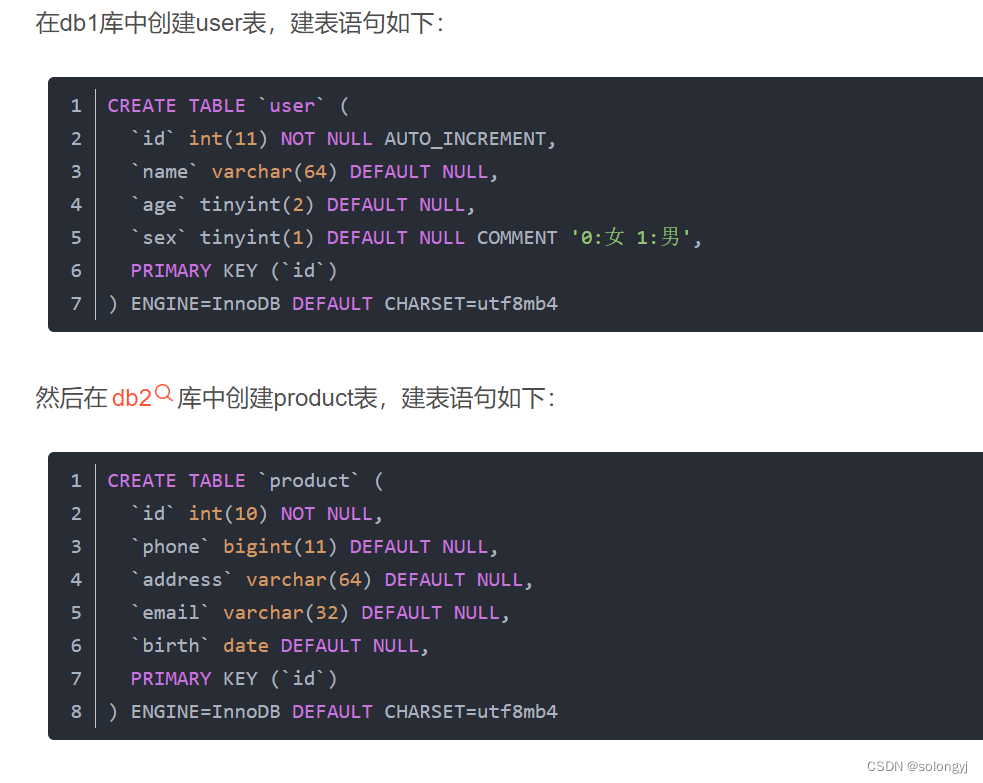
因为已经分别在两个不同的库创建了两张表,db1库里是user表,db2库里是product表,这里把product表中的id设为自增,然后先启动该项目执行一下插入一些数据(上面连接里有详细介绍):
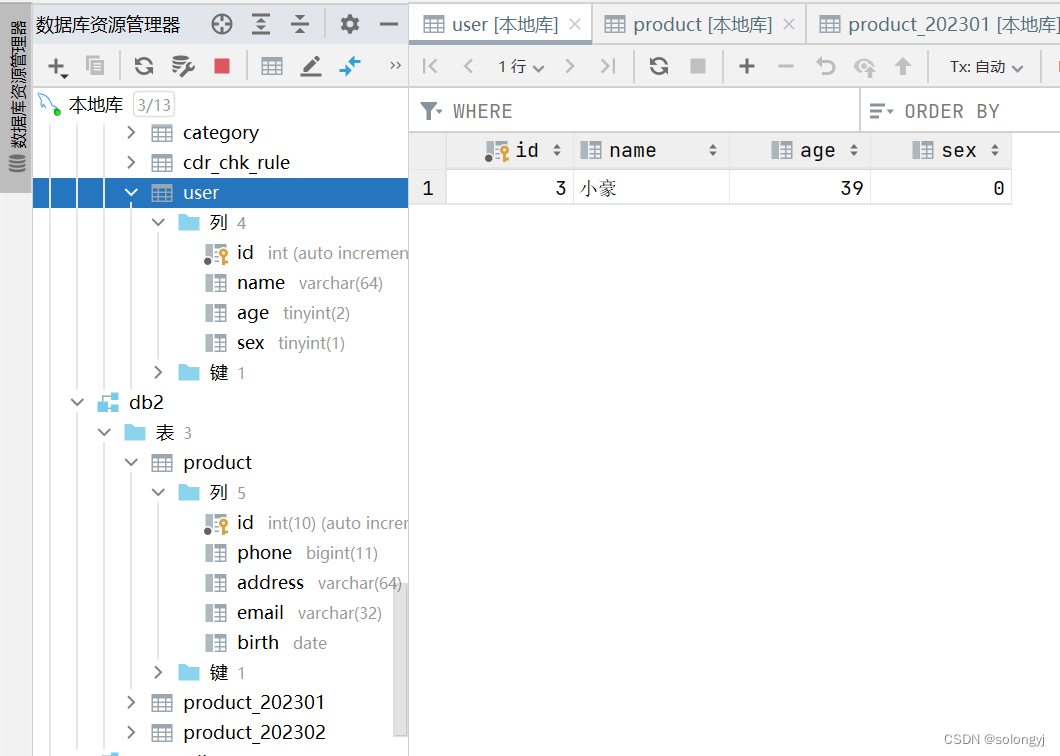
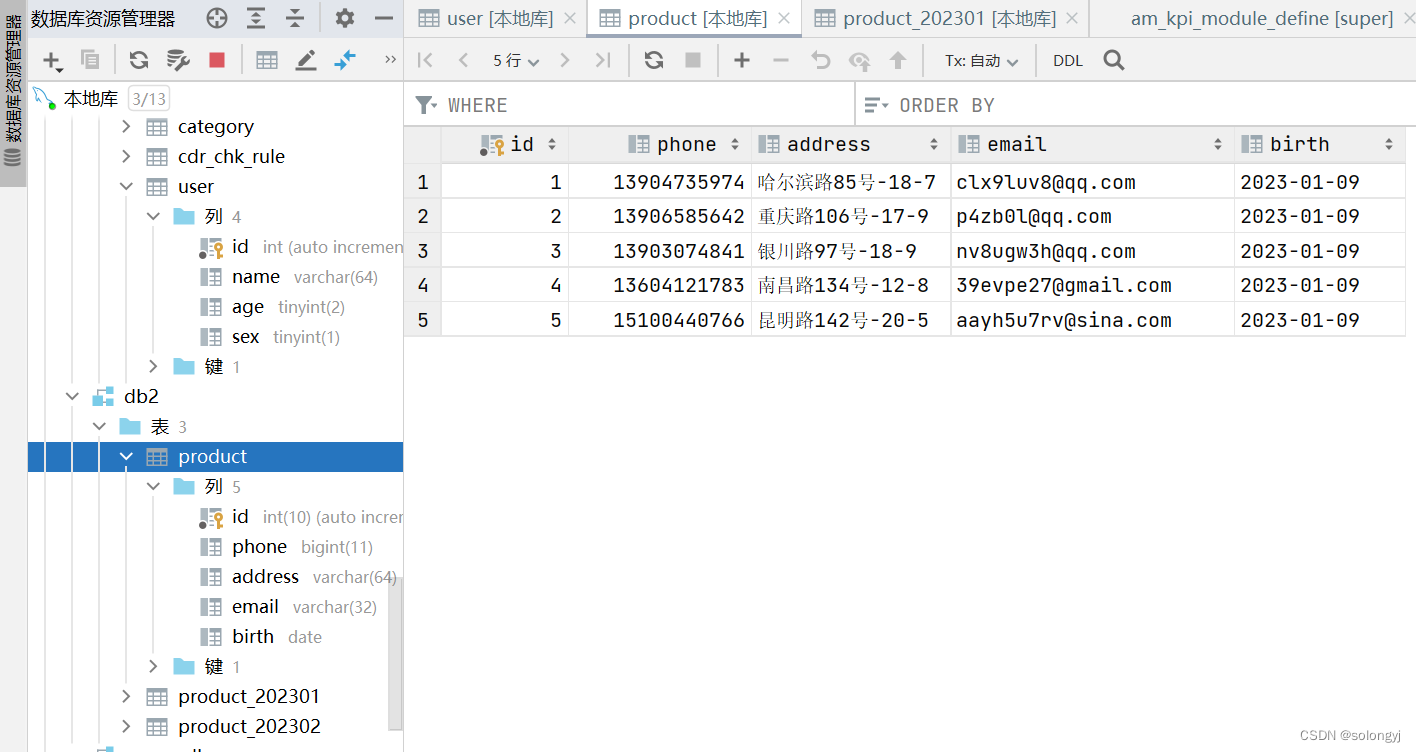
现在user表里有一条数据,product表里有五条数据,然后我们建两张product的月表product_202301和product_202302,接下来开始进行如何插入对应的月表开发:简单的说就是mybatis在执行sql的时候,拦截目标方法并且在前后加上我们的业务逻辑。实际上就是加@Intercepts注解和实现org.apache.ibatis.plugin.Interceptor接口;

首先创建一个类实现该接口,话不多说直接上代码:
//method = "query"拦截select方法、而method = "update"则能拦截insert、update、delete的方法
@Intercepts({@Signature(type = Executor.class, method = "update", args = {MappedStatement.class, Object.class})})
@Component
public class ReplaceTableInterceptor implements Interceptor {
private final static Map<String, String> TABLE_MAP = new LinkedHashMap<>();
static {
//截取当前时间对应的月份,格式yyyyMM
String month = new SimpleDateFormat("yyyyMM").format(new Date());
//插入product表时,替换为对应的月表
TABLE_MAP.put("product", "product_" + month);
}
@Override
public Object intercept(Invocation invocation) throws Throwable {
Object[] args = invocation.getArgs();
//获取MappedStatement对象
MappedStatement ms = (MappedStatement) args[0];
//获取传入sql语句的参数对象
Object parameterObject = args[1];
BoundSql boundSql = ms.getBoundSql(parameterObject);
//获取到拥有占位符的sql语句
String sql = boundSql.getSql();
System.out.println("拦截前sql :" + sql);
//判断是否需要替换表名
if(isReplaceTableName(sql)){
for(Map.Entry<String, String> entry : TABLE_MAP.entrySet()){
sql = sql.replace(entry.getKey(),entry.getValue());
}
System.out.println("拦截后sql :" + sql);
//重新生成一个BoundSql对象
BoundSql bs = new BoundSql(ms.getConfiguration(),sql,boundSql.getParameterMappings(),parameterObject);
//重新生成一个MappedStatement对象
MappedStatement newMs = copyMappedStatement(ms, new BoundSqlSqlSource(bs));
//赋回给实际执行方法所需的参数中
args[0] = newMs;
}
return invocation.proceed();
}
/***
* 复制一个新的MappedStatement
* @param ms
* @param newSqlSource
* @return
*/
private MappedStatement copyMappedStatement (MappedStatement ms, SqlSource newSqlSource) {
MappedStatement.Builder builder = new MappedStatement.Builder(ms.getConfiguration(), ms.getId(), newSqlSource, ms.getSqlCommandType());
builder.resource(ms.getResource());
builder.fetchSize(ms.getFetchSize());
builder.statementType(ms.getStatementType());
builder.keyGenerator(ms.getKeyGenerator());
if (ms.getKeyProperties() != null && ms.getKeyProperties().length > 0) {
builder.keyProperty(String.join(",",ms.getKeyProperties()));
}
builder.timeout(ms.getTimeout());
builder.parameterMap(ms.getParameterMap());
builder.resultMaps(ms.getResultMaps());
builder.resultSetType(ms.getResultSetType());
builder.cache(ms.getCache());
builder.flushCacheRequired(ms.isFlushCacheRequired());
builder.useCache(ms.isUseCache());
return builder.build();
}
/***
* 判断是否需要替换表名
* @param sql
* @return
*/
private boolean isReplaceTableName(String sql){
for(String tableName : TABLE_MAP.keySet()){
if(sql.contains(tableName)){
return true;
}
}
return false;
}
/***
* MappedStatement构造器接受的是SqlSource
* 实现SqlSource接口,将BoundSql封装进去
*/
public static class BoundSqlSqlSource implements SqlSource {
private BoundSql boundSql;
public BoundSqlSqlSource(BoundSql boundSql) {
this.boundSql = boundSql;
}
@Override
public BoundSql getBoundSql(Object parameterObject) {
return boundSql;
}
}
@Override
public Object plugin(Object target) {
return Plugin.wrap(target,this);
}
@Override
public void setProperties(Properties properties) {
Interceptor.super.setProperties(properties);
}
}
注意:在intercept方法中有参数Invocation对象,里面有3个成员变量和@Signature对应

其中target为代理对象,method为被拦截的方法,args为被拦截方法执行所需的参数;
通过Invocation中的args变量。我们能拿到MappedStatement这个对象(args[0]),传入sql语句的参数Object(args[1])。而MappedStatement是一个记录了sql语句(sqlSource对象)、参数值结构、返回值结构、mapper配置等的一个对象。
sqlSource对象和传入sql语句的参数对象Object就能获得BoundSql。BoundSql的toString方法就能获取到有占位符的sql语句了,我们的业务逻辑就能在这里介入。
获取到sql语句,根据规则替换表名,塞回BoundSql对象中、再把BoundSql对象塞回MappedStatement对象中。最后再赋值给args[0](实际被拦截方法所需的参数)就搞定了。
到这里,mybatis拦截实现分表的功能就已经写好了,但这样还无法实现插入数据时到对应的月表,因为我们还缺少一些配置,因为我们是对db2库里的表进行按月分表的,所以找到db2的配置类:DataSourceDb2Config ,代码如下:
@Configuration
@MapperScan(basePackages = "com.solongyj.demo.mapper.db2", sqlSessionTemplateRef = "db2SqlSessionTemplate")
public class DataSourceDb2Config {
/**
* 获取映射文件所在的路径
*/
@Value("${mybatis.db2.mapper-locations}")
private String db2tMapperPath;
/**
* 数据源加载
*
* @return
*/
@Bean(name = "db2DataSource")
@ConfigurationProperties(prefix = "spring.datasource.db2.druid")
public DataSource test1DataSource() {
return DataSourceBuilder.create().build();
}
/**
* 注入SqlSessionFactory,指定数据源和映射文件路径
*
* @param dataSource
* @return
* @throws Exception
*/
@Bean(name = "db2SqlSessionFactory")
public SqlSessionFactory testSqlSessionFactory(@Qualifier("db2DataSource") DataSource dataSource) throws Exception {
MybatisSqlSessionFactoryBean bean = new MybatisSqlSessionFactoryBean();
bean.setDataSource(dataSource);
Resource[] resources = new PathMatchingResourcePatternResolver().getResources(db2tMapperPath);
bean.setMapperLocations(resources);
return bean.getObject();
}
/**
* 注入DataSourceTransactionManager事物管理器
*
* @param dataSource
* @return
*/
// @Bean(name = "db2TransactionManager")
public DataSourceTransactionManager testTransactionManager(@Qualifier("db2DataSource") DataSource dataSource) {
return new DataSourceTransactionManager(dataSource);
}
/**
* @param sqlSessionFactory
* @return
* @throws Exception
*/
@Bean(name = "db2SqlSessionTemplate")
public SqlSessionTemplate testSqlSessionTemplate(@Qualifier("db2SqlSessionFactory") SqlSessionFactory sqlSessionFactory) throws Exception {
return new SqlSessionTemplate(sqlSessionFactory);
}此时还需要在testSqlSessionFactory方法中添加刚才写好的拦截器,最后代码为:
@Configuration
@MapperScan(basePackages = "com.solongyj.demo.mapper.db2", sqlSessionTemplateRef = "db2SqlSessionTemplate")
public class DataSourceDb2Config {
/**
* 获取映射文件所在的路径
*/
@Value("${mybatis.db2.mapper-locations}")
private String db2tMapperPath;
/**
* 数据源加载
*
* @return
*/
@Bean(name = "db2DataSource")
@ConfigurationProperties(prefix = "spring.datasource.db2.druid")
public DataSource test1DataSource() {
return DataSourceBuilder.create().build();
}
/**
* 注入SqlSessionFactory,指定数据源和映射文件路径
*
* @param dataSource
* @return
* @throws Exception
*/
@Bean(name = "db2SqlSessionFactory")
public SqlSessionFactory testSqlSessionFactory(@Qualifier("db2DataSource") DataSource dataSource) throws Exception {
MybatisSqlSessionFactoryBean bean = new MybatisSqlSessionFactoryBean();
bean.setDataSource(dataSource);
Resource[] resources = new PathMatchingResourcePatternResolver().getResources(db2tMapperPath);
bean.setMapperLocations(resources);
//添加对应的拦截器,如有多个拦截器可使用new Interceptor[]{拦截器,中间用逗号隔开}
bean.setPlugins(new SplitTableInterceptor());
return bean.getObject();
}
/**
* 注入DataSourceTransactionManager事物管理器
*
* @param dataSource
* @return
*/
// @Bean(name = "db2TransactionManager")
public DataSourceTransactionManager testTransactionManager(@Qualifier("db2DataSource") DataSource dataSource) {
return new DataSourceTransactionManager(dataSource);
}
/**
* @param sqlSessionFactory
* @return
* @throws Exception
*/
@Bean(name = "db2SqlSessionTemplate")
public SqlSessionTemplate testSqlSessionTemplate(@Qualifier("db2SqlSessionFactory") SqlSessionFactory sqlSessionFactory) throws Exception {
return new SqlSessionTemplate(sqlSessionFactory);
}
}
然后启动项目使用postman进行测试
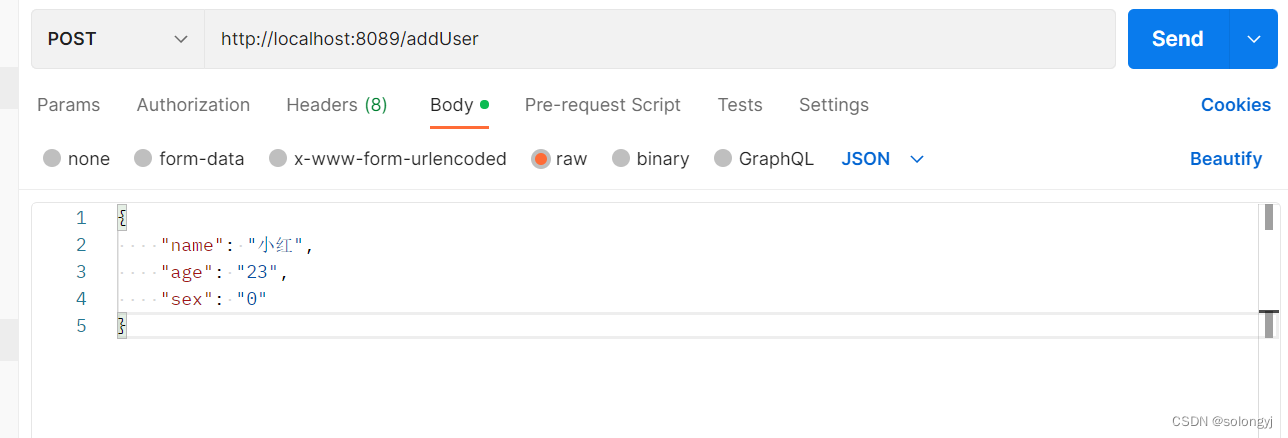
可以通过日志看到:
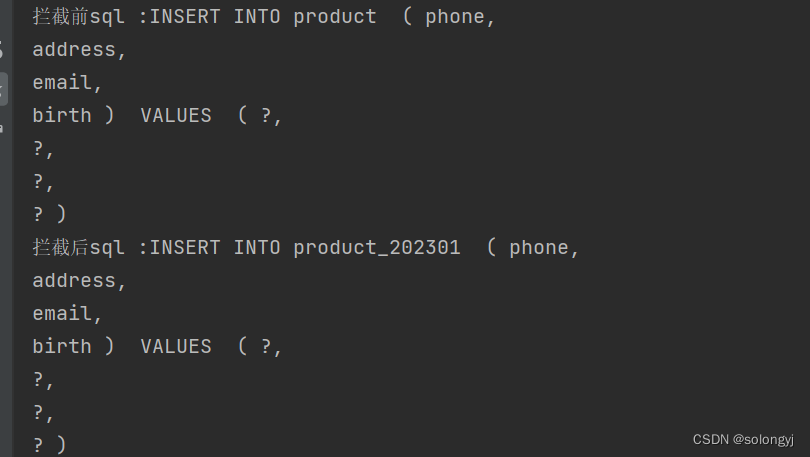

最后查看数据库:product_202301表中新增一条数据:
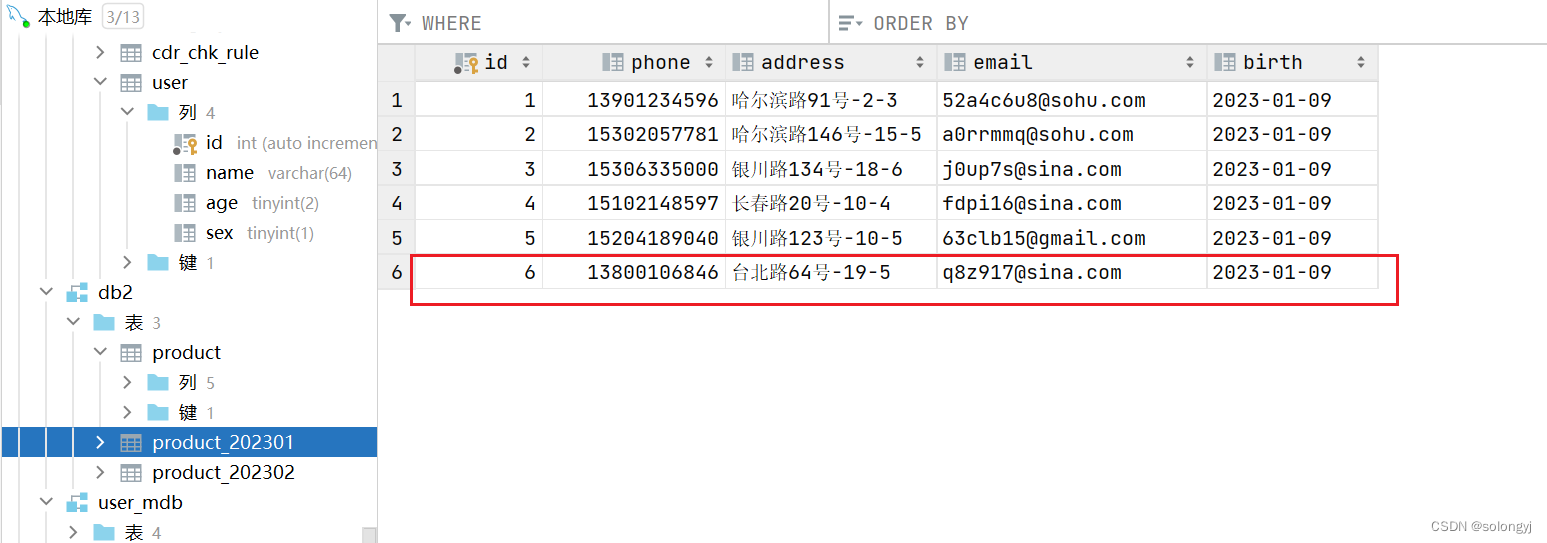
至此,使用mybatis拦截器实现分表功能已实现;该方法不仅适用于按月分表,也同样适用于根据用户id或手机尾号插入对应的分表中。与其说是分表,不如说它是动态替换表名更合适,哪怕没有product这个表,只要TABLE_MAP.put("product","value");中value值在数据库中有其对应的表,最后操作的都是value表;相关代码已上传至https://gitee.com/solongyj/spring2db.git,感兴趣的朋友可以了解下。




















 448
448











 被折叠的 条评论
为什么被折叠?
被折叠的 条评论
为什么被折叠?








